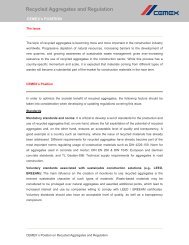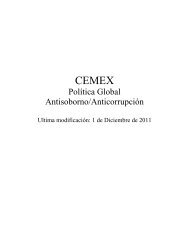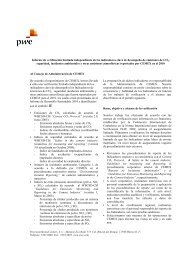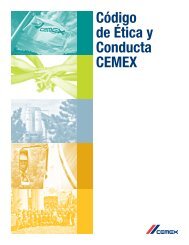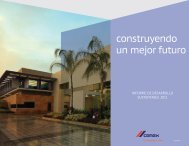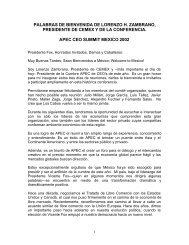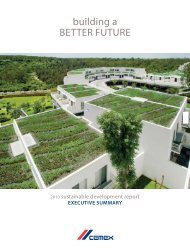building a STRONGER foundation - Cemex
building a STRONGER foundation - Cemex
building a STRONGER foundation - Cemex
You also want an ePaper? Increase the reach of your titles
YUMPU automatically turns print PDFs into web optimized ePapers that Google loves.
There are two primary processes used to manufacture cement: the dry process and the wet process. The dry process is more fuel<br />
efficient. As of December 31, 2010, 58 of our 62 operative production plants used the dry process and four used the wet process. Our<br />
operative production plants that use the wet process are located in Colombia, Nicaragua and the United Kingdom. In the wet process,<br />
the raw materials are mixed with water to form slurry, which is fed into a kiln. Fuel costs are greater in the wet process than in the dry<br />
process because the water that is added to the raw materials to form slurry must be evaporated during the clinker manufacturing<br />
process. In the dry process, the addition of water and the formation of slurry are eliminated, and clinker is formed by calcining the dry<br />
raw materials. In the most modern application of this dry process technology, the raw materials are first blended in a homogenizing<br />
silo and processed through a pre-heater tower that utilizes exhaust heat generated by the kiln to pre-calcine the raw materials before<br />
they are calcined to produce clinker.<br />
Clinker and gypsum are fed in pre-established proportions into a cement grinding mill where they are ground into an extremely<br />
fine powder to produce finished cement. We primarily cover our gypsum needs from third parties; however, we also operate gypsum<br />
quarries in the United States, Spain, Dominican Republic and Egypt.<br />
Ready-Mix Concrete<br />
Ready-mix concrete is a combination of cement, fine and coarse aggregates, admixtures (which control properties of the<br />
concrete including plasticity, pumpability, freeze-thaw resistance, strength and setting time), and water. We tailor our ready-mix<br />
concrete to fit our clients’ specific needs. By changing the proportion of water, aggregates, and cement in the mix, we modify our<br />
concrete’s resistance, manageability, and finish. We also use additives to customize our concrete consistent with the transportation<br />
time from our plant to the project, weather conditions at the construction site, and the project’s specifications. From our water-resistant<br />
to our self-compacting concrete, we produce a great variety of specially designed concrete to meet the many challenges of modern<br />
construction.<br />
As part of our development and innovation strategy, in April 2011, we launched Promptis, our first global brand of ready-mix<br />
concrete. Promptis has been designed to retain workability for over 90 minutes, thus allowing the material to be easily handled before<br />
reaching its early compressive strength in as fast as 4 hours, allowing customers to increase efficiency in their projects.<br />
Aggregates<br />
We are one of the world’s largest suppliers of aggregates: primarily the crushed stone, sand and gravel, used in virtually all<br />
forms of construction. Customers use our aggregates for a wide array of uses, from a key component in the construction and<br />
maintenance of highways, walkways, and railways to an indispensable ingredient in concrete, asphalt, and mortar.<br />
Aggregates are obtained from land-based sources such as sand and gravel pits and rock quarries or by dredging marine deposits.<br />
See “— Description of our raw materials reserves.”<br />
Hard Rock Production. Rock quarries usually operate for at least 30 years and are developed in distinct benches or steps. A<br />
controlled explosion is normally used to release the rock from the working face. It is then transported by truck or conveyor to a<br />
crusher to go through a series of crushing and screening stages to produce a range of final sizes to suit customers’ needs. Dry stone is<br />
delivered by road, rail or water from the quarry.<br />
Sand and Gravel Production. Sand and gravel quarries are much shallower than rock quarries and are usually worked and<br />
restored in progressive phases. Water can either be pumped out of the quarries allowing them to be worked dry or they can be operated<br />
as lakes with extraction below water. A conveyor draws the raw material into the processing plant where it is washed to remove<br />
unwanted clay and to separate sand. Sand separated during processing is dewatered and stockpiled. Gravel then passes over a series of<br />
screens that sieve the material into different sizes. Processing separates the gravel into stockpiles in a range of sizes for delivery.<br />
Marine Aggregate Production. A significant proportion of the demand for aggregates is satisfied from rivers, lakes, and seabeds.<br />
Marine resources are increasingly important to the sustainable growth of the <strong>building</strong> materials industry. Marine aggregates also play<br />
an important role in replenishing beaches and protecting coastlines from erosion. At sea, satellite navigation is used to position a<br />
vessel precisely within its licensed dredging area. Vessels trail a pipe along the seabed and use powerful suction pumps to draw sand<br />
and gravel into the cargo hold. Dredged material is discharged at wharves, where it is processed, screened and washed for delivery.<br />
Description of our raw materials reserves<br />
We are a leading global provider of <strong>building</strong> materials, including cement, ready-mix concrete and aggregates. Our cement<br />
production process begins with the mining and crushing of limestone and clay, and, in some instances, other raw materials. We have<br />
access to limestone and clay quarries near most of our cement plant sites worldwide since these minerals are the main raw materials in<br />
the cement production process.<br />
34



